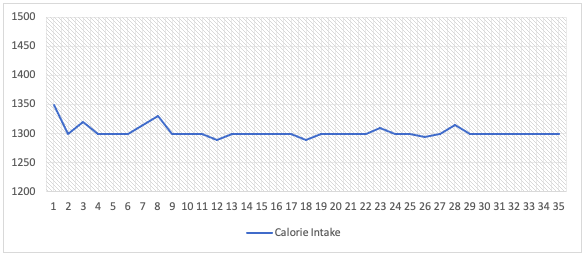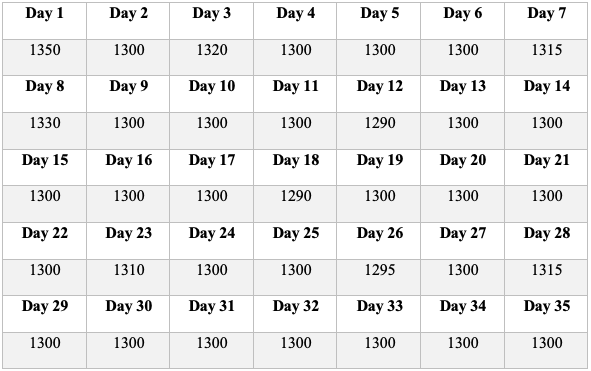Introduction
Healthcare specialists prioritize delivering high-quality care in pursuit of positive patient outcomes. In the modern world, requirements for the grade of medical assistance have increased, demanding proficiency for clinical outcomes and being people-centered (“Improvement science,” n.d.; Johnson & Sollecito, 2020). Therefore, it is necessary for those working in the healthcare sector to continuously advance themselves to offer sufficient services to individuals seeking treatment. Medical experts must strive for personal improvement to facilitate organizational development and provide better care.
Aim
The present personal project aims to enhance my health by losing weight through exercise. Excessive body poundage is a risk factor associated with such conditions as type 2 diabetes, hypertension, sleep apnea, asthma, osteoarthritis, and several heart diseases (Anwar et al., 2021). Moreover, recent findings suggest that obesity can elevate the severity of COVID-19 and potentially generate further complications (Anwar et al., 2021). Therefore, the aim of the current project is for me to decrease my weight from 150 lbs to approximately 120 to 125 lbs by exercising more, which is illustrated in a graph in Appendix A.
Process Analysis
The procedure leading to the desired results was similar throughout most days of the assignment and is demonstrated in Appendix B. The process map (PM), or flowchart, depicts the primary steps to lose weight (Johnson & Sollecito, 2020; Neuhauser et al., 2001). First, after waking up, poundage was monitored utilizing scales, recorded, and compared to the last measurement to note any difference.
Second, it was resolved to exercise three times a week, so it was necessary to decide whether a particular day was the day of being more physically active than usual. Third, before going to sleep, calorie intake was measured after all meals and recorded every twenty-four hours. While having a goal of consuming 1300 daily, there was a difference on some occasions for various reasons. The process was intended to be repeated daily until the desired result was achieved.
Furthermore, I was the only person involved in all the project stages due to the essence of the main objective. Although one of the main advantages of a PM is that it depicts each individual’s duties, I was the one responsible for the success of my aim (Johnson & Sollecito, 2020). I did not need assistance exercising, taking measurements, or recording data. Therefore, it is not possible to identify people involved in the process since its execution depended solely on me.
Measurement
The project concentrated on measuring weight, calories, and workout routines. The data collection method used was an observation based on minding the three units (Ganesha & Aithal, 2022). The approach allowed monitoring my behavior alongside changes in weight toward achieving the set objective. Each listed parameter was scrutinized separately with varying focus, shown in Appendix C. First, weight was measured utilizing regular scales and is represented in Appendix D, with information from week one of the project until the start of week six, so 35 days in general.
Second, data on calories are demonstrated in Appendix E and were calculated manually considering the average calories of food items. Third, workout routines were examined based on the amount, duration, and intensity of exercises illustrated in Appendix F. Although the goal was to run one mile three times a week, there were some differences due to running slower on some occasions or faster after having a good rest. The measurements are exhibited utilizing graphs and tables to display progress.
Changes
Changes that were implemented started in the second week of the improvement process and were concerned with both diet and workout routines. First, to ensure that I consume 1300 calories, I stopped eating certain food items on day four. For example, I only drank water, avoided sugary beverages like juice, soda, and tea, and replaced all snacks with vegetables. Such a shift in diet worked well since it became easier to control calorie intake. Second, my muscles felt sore and ached after the initial run, so moving on the following days was laborious. Therefore, I added stretching exercises to my physical activities since week two.
Nonetheless, what did not work was trying to replace running with yoga because the latter was time-consuming yet felt not dynamic enough to reduce excessive poundage. Not many modifications were executed because, unlike other improvement goals, it is not recommended to lose weight quickly since a prompt reduction may be neither sustainable nor clinically healthy (Gordon et al., 2019). Changes upon beginning the project were meant to aid in decreasing weight without overwhelming the body while assisting it in getting accustomed to a physically dynamic lifestyle.
Reflection and Application
The personal improvement project was insightful and presented several lessons. I experienced some hardships being active, and I often wished I could eat more due to frequently feeling hungry. It was hard for my body to become accustomed to daily exercises, and finding opportunities to work out was challenging.
However, I learned how to allocate my time more effectively and motivate myself to achieve more when I am tired. I have discovered practical information about different types of food by examining their calorific value and ingredients. I also realized that concentrating on quickly losing weight should not be a priority since a prompt result may not necessarily be the most enduring and influential (Gordon et al., 2019).
Nonetheless, potentially, the most important lesson I have understood is not to compare my progress to someone else’s. For instance, when going for a run, I saw other people exercising and noted that each had varying levels of training. Overall, the project was quite helpful, and while I have yet to achieve the desired poundage, I now better comprehend what should be done to reach my goal.
Furthermore, the improvement will persist and be maintained by following several steps. First, the progress will be monitored further regarding the three abovementioned parameters since collecting data has proven helpful in controlling accomplishments and recognizing the need for changes (Gordon et al., 2019).
Second, as the body has adjusted to regular running, the workout routines will be intensified by gradually adding aerobic exercises to increase weight reduction with an orientation on long-term effects (Bellicha et al., 2021).
Third, physical activity will continue to preserve the result upon reaching the primary aim. Still, calories will not be restricted to prevent the possibility of decreasing a healthy poundage. Nevertheless, sugary items will stay excluded, while vegetables will be consumed daily. Consequently, the ongoing improvement will be maintained by remaining dynamic, eating healthier products, monitoring progress, and implementing changes if required.
Knowledge obtained from the project can be employed in a clinical setting. The experience can be utilized to explain to colleagues that there is always a necessity for advancement because quality provisions in a nursing workplace continue to rise (“Improvement science,” n.d.). For instance, there may be a unit-level demand to enhance patients’ involvement in decision-making, or patient safety may need to be elevated on an organizational level (Stausmire et al., 2015).
The knowledge can be used to ensure that the implementation of modification involves experts guided by evidence-based practice alongside nursing research (“Improvement science,” n.d.; Stausmire et al., 2015). Although one person executed the current project, more intricate tasks will require the assistance of professionals from different areas (Stausmire et al., 2015). The experience can be utilized to collect data about potential transformation to determine whether it is an improvement (Johnson & Sollecito, 2020; Neuhauser et al., 2001).
For example, while a shift may address a high-risk population within a unit, the same modification may not apply to the organization (Stausmire et al., 2015). Therefore, the obtained knowledge can facilitate a clinical change by correctly approaching and guiding it.
The acquired experience can be utilized in a nursing setting by, for instance, proposing a group intervention on weight loss for patients with specific health conditions. As mentioned above, excessive poundage is associated with such ailments as type 2 diabetes, hypertension, and sleep apnea (Anwar et al., 2021).
Accordingly, there may be a need to help individuals from different units of an institution to lower their weight to facilitate treatment. In addition to the way described by the overhead of employing the obtained knowledge, the personal improvement experience can assist in a clinical setting by understanding that reducing one’s poundage may be an intricate process.
For example, patients should not be rushed to lose weight but should be monitored and assisted appropriately based on insights from collected data. Consequently, information from the project can aid in an intervention to manage the excessive poundage of specific patients.
Conclusion
To conclude, healthcare specialists must strive for personal improvement to enable institutional development and provide better care. In modern times, medical professionals face a growth of requirements for quality, indicating that experts should concentrate on advancing themselves and their organizations. The present project aimed at decreasing my weight, and although the objective is yet to be achieved due to being quite time-consuming, I have gained substantial knowledge about implementing a change toward advancement.
References
Anwar, F., Tayyab, M., Haq, I., & Shah, O. U. (2021). Viral overload of COVID-19 pandemics: Overweight people a soft target to get an infection. International Journal of Clinical Virology, 5(2), 070-071. Web.
Bellicha, A., van Baak, M. A., Battista, F., Beaulieu, K., Blundell, J. E., Busetto, L., Carraça, E. V., Dicker, D., Encantado, J., Ermolao, A., Farpour-Lambert, N., Pramono, A., Woodward, E., & Oppert, J. M. (2021). Effect of exercise training on weight loss, body composition changes, and weight maintenance in adults with overweight or obesity: An overview of 12 systematic reviews and 149 studies. Obesity Reviews, 22(4), 1-13. Web.
Ganesha, H. R., & Aithal, P. S. (2022). How to choose an appropriate research data collection method and method choice among various research data collection methods and method choices during Ph. D. program in India? International Journal of Management, Technology, and Social Sciences, 7(2), 455-489. Web.
Gordon, M., Althoff, T., & Leskovec, J. (2019). Goal-setting and achievement in activity tracking apps: A case study of MyFitnessPal. The World Wide Web Conference, 571-582. Web.
Improvement science defined: Narrative [TXT file]. (n.d.).
Johnson, J. K., & Sollecito, W. A. (2020). McLaughlin & Kaluzny’s continuous quality improvement in health care (5th ed.). Jones and Bartlett Learning.
Neuhauser, D., Myhre, S., & Alemi, F. (2001). Personal continuous improvement work book. Kingsham Press.
Stausmire, J. M., & Ulrich, C. (2015). Making it meaningful: Finding quality improvement projects worthy of your time, effort, and expertise. Critical Care Nurse, 35(6), 57-61. Web.
Appendix A – Aim
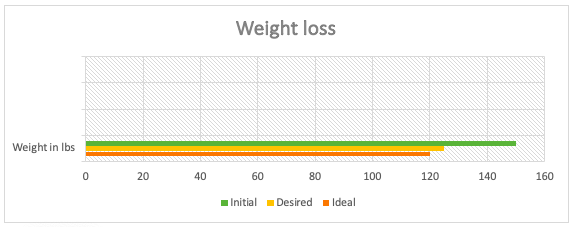
Appendix B – Process Map
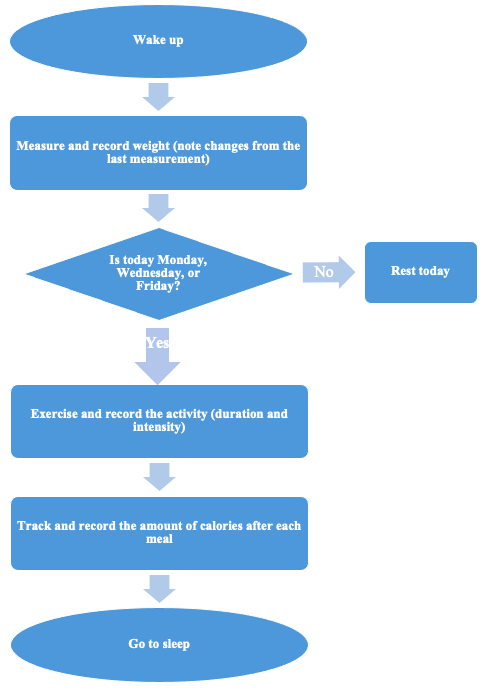
Appendix C – Measurements
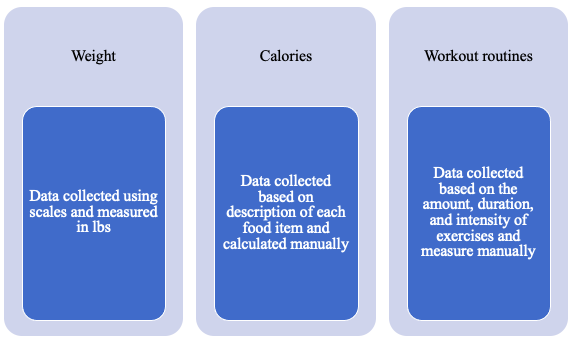
Appendix D – Weight
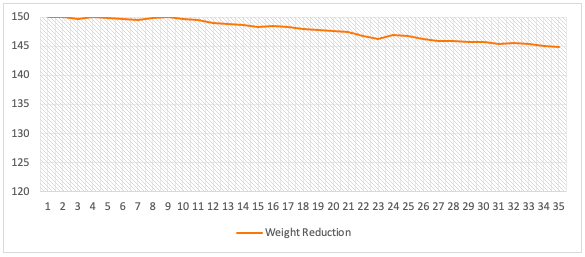
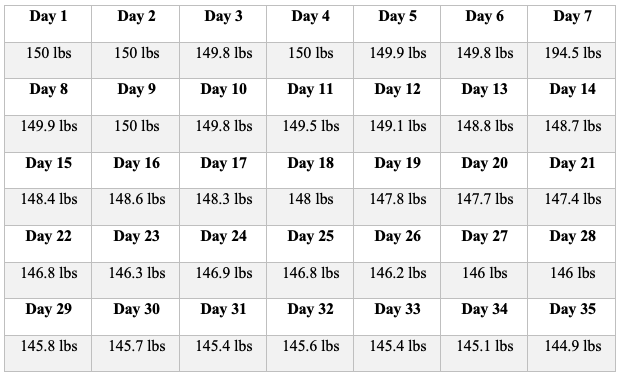
Appendix E – Calories
